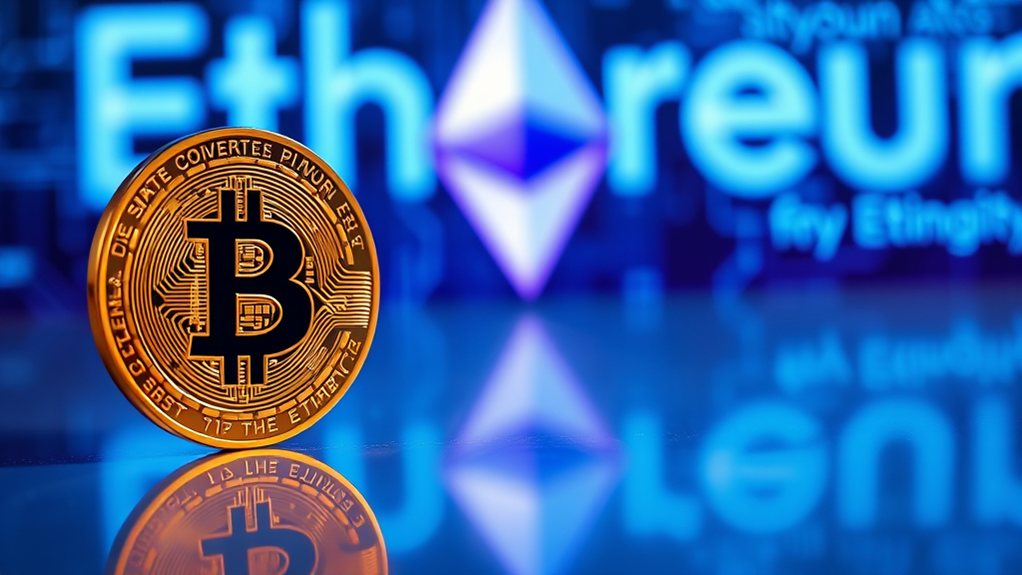Wrapped Bitcoin (WBTC) is a digital token that represents Bitcoin on the Ethereum blockchain. It's an ERC-20 token pegged 1:1 to Bitcoin's value, allowing Bitcoin holders to participate in Ethereum's DeFi ecosystem. When users deposit Bitcoin with a custodian like BitGo, they receive an equal amount of WBTC in return. This bridge between networks offers faster transactions and access to new financial tools. The full story reveals important considerations about custody and alternatives.

Wrapped Bitcoin (WBTC) is a digital token that brings Bitcoin to the Ethereum blockchain. It's an ERC-20 token that's pegged to Bitcoin at a 1:1 ratio, meaning one WBTC is always worth the same as one Bitcoin. This special token allows Bitcoin holders to participate in Ethereum's decentralized finance (DeFi) ecosystem without selling their Bitcoin. It acts as a bridge between the two largest blockchain networks.
Bridging Bitcoin and Ethereum worlds, WBTC enables crypto holders to access DeFi opportunities without sacrificing their BTC position.
The process of creating WBTC is straightforward but involves several steps. When someone wants to convert Bitcoin to WBTC, they send their Bitcoin to a custodian like BitGo. The custodian then mints an equal amount of WBTC on the Ethereum blockchain. These tokens can be traded, used in various DeFi applications, or later redeemed for the original Bitcoin. Smart contracts guarantee that each WBTC is backed by real Bitcoin held in reserve.
Several key players make the WBTC ecosystem work smoothly. Merchants help users wrap and unwrap their Bitcoin. Custodians securely store the Bitcoin reserves. The WBTC DAO (Decentralized Autonomous Organization) oversees the entire protocol and makes certain everything remains transparent. The DAO utilizes multi-signature contracts to govern all activities related to the protocol. Users can verify the Bitcoin reserves backing WBTC at any time. This system maintains consistent value representation for all users who participate in the ecosystem.
WBTC offers several advantages over using regular Bitcoin. Transactions on Ethereum are typically faster than on the Bitcoin network. Fees can be lower when using Ethereum. Bitcoin holders gain access to Ethereum's growing DeFi ecosystem, where they can earn interest on their Bitcoin or use it as collateral for loans. It also increases liquidity in decentralized exchanges. Users can trade WBTC on various peer-to-peer marketplaces without intermediaries, maintaining custody of their funds throughout the process.
People use WBTC in many different ways. It serves as collateral for lending and borrowing in DeFi protocols. Traders provide WBTC as liquidity in decentralized exchanges. Some users stake their WBTC to earn additional yield. Others simply trade it against other cryptocurrencies. The flexibility of WBTC opens up many possibilities for Bitcoin holders.
Despite its benefits, WBTC does come with some risks. It relies on custodians to hold the Bitcoin, creating a centralization risk. Smart contracts could potentially have vulnerabilities. Sometimes, small price differences might exist between WBTC and regular Bitcoin. Regulations around wrapped assets remain unclear in many regions.
WBTC isn't the only option for bringing Bitcoin to Ethereum. Alternatives include renBTC, tBTC, sBTC, hBTC, and pBTC. Each has its own approach to solving the Bitcoin-Ethereum bridge problem. However, WBTC remains one of the most widely adopted solutions with significant usage across the DeFi ecosystem.
Frequently Asked Questions
How Does the Minting Process of WBTC Work?
The WBTC minting process involves several steps.
First, a merchant receives Bitcoin from a user and completes KYC checks. The merchant sends this Bitcoin to a custodian who stores it safely.
After verification, the custodian mints an equal amount of WBTC tokens. A smart contract executes this minting on the Ethereum blockchain.
DAO members verify the process, and proof of reserves is published publicly.
What Are the Risks Associated With Holding WBTC?
WBTC holders face several key risks.
Custodial risk exists because centralized entities hold the backing Bitcoin reserves.
Smart contract vulnerabilities could be exploited by hackers.
Regulatory uncertainty looms as governments may impose new rules on wrapped tokens.
Market risks include potential price divergence from Bitcoin and liquidity issues.
During market stress, WBTC might trade at different prices than Bitcoin, and the redemption process could slow down.
Can WBTC Be Used in Decentralized Finance Applications?
WBTC is widely used in decentralized finance applications.
It serves as collateral on lending platforms like Aave and Compound, allowing holders to borrow other cryptocurrencies. It's traded on decentralized exchanges such as Uniswap.
Users can stake WBTC in liquidity pools to earn rewards through yield farming.
It's also compatible with DeFi aggregators like Zapper and works with popular wallets like MetaMask for easy portfolio tracking.
How Does Wbtc's Price Compare to Regular Bitcoin?
WBTC's price closely mirrors Bitcoin's price, maintaining a nearly 1:1 ratio by design.
The two assets are highly correlated, with WBTC typically trading within a fraction of a percent of Bitcoin's value. Small price discrepancies can occur due to market inefficiencies, creating arbitrage opportunities for traders.
While both experience similar volatility patterns, WBTC may show slightly less price movement due to its lower trading volume compared to Bitcoin.
Are There Alternatives to WBTC for Bitcoin on Ethereum?
Several alternatives to WBTC exist for using Bitcoin on Ethereum.
tBTC offers permissionless minting through a network of signers but has less liquidity.
renBTC provides a trustless bridge using dark nodes with lower fees.
The upcoming sBTC on Stacks blockchain aims to leverage Bitcoin's security when it launches in 2024.
Atomic swaps allow direct peer-to-peer exchanges without wrapping, though they're more complex and slower than other options.










